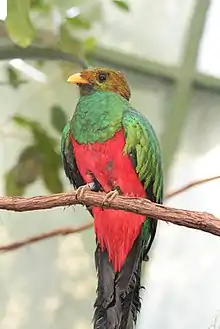Quetzal
Quetzals (/kɛtˈsɑːl, ˈkɛtsəl/) are strikingly colored birds in the trogon family. They are found in forests, especially in humid highlands, with the five species from the genus Pharomachrus being exclusively Neotropical, while a single species, the eared quetzal, Euptilotis neoxenus, is found in Mexico and very locally in the southernmost United States.[1] Quetzals are fairly large (all over 32 cm or 13 inches long), slightly bigger than other trogon species.[2][3] The resplendent quetzal is the national bird of Guatemala because of its vibrant colour.
| Quetzal | |
|---|---|
 | |
| Golden-headed quetzal | |
| Scientific classification | |
| Kingdom: | |
| Phylum: | |
| Class: | |
| Order: | |
| Family: | |
| Genera | |
_(one_of_a_pair)_MET_DP-12314-002.jpg.webp)
Quetzals have iridescent green or golden-green wing coverts, back, chest and head, with a red belly. They are strongly sexually dimorphic, and parts of the females' plumage are brown or grey. These largely solitary birds feed on fruits, berries, insects and small vertebrates (such as frogs).[2][3] Even with their famous bright plumage, they can be hard to see in their natural wooded habitats.
Conservation status
None of the many quetzal species are under immediate threat in the wild, although the eared and resplendent quetzal are at the Near Threatened status.[4] Pharomachrus mocinno is dependent on standing dead and mature trees for breeding holes, which are only formed in primary cloud forest; the species' breeding behavior is linked to the long term existence of these forests such as the few remaining in highland Guatemala.[5] The remaining are not considered threatened by the IUCN and all are locally common.[2][3]
Etymology
The name quetzal is from Nahuatl quetzalli [keˈt͡salːi], "large brilliant tail feather" (American Audubon Dictionary) or "tail coverts of the quetzal" (Merriam-Webster's Collegiate Dictionary), from the Nahuatl root quetz = "stand up" used to refer to an upstanding plume of feathers. The word entered English through Spanish.
The word quetzal was originally used for just the resplendent quetzal, the long-tailed quetzal of Guatemala, (more specifically a town called Petén) which is the national bird and the name of the currency of Guatemala. It still often refers to that bird specifically but now also names all the species of the genera Pharomachrus and Euptilotis.
Pharomachrus is from Ancient Greek φάρος pharos, "mantle", and μακρός makros, "long", referring to the wing and tail coverts of the resplendent quetzal (the second h is unexplained).
Species
Genus Pharomachrus:
- Crested quetzal, Pharomachrus antisianus.
- Golden-headed quetzal, Pharomachrus auriceps.
- White-tipped quetzal, Pharomachrus fulgidus.
- Resplendent quetzal, Pharomachrus mocinno.
- Pavonine quetzal, Pharomachrus pavoninus.
Genus Euptilotis:
- Eared quetzal, Euptilotis neoxenus.
- Euptilotis neoxenus is related to Pharomachrus and is called the eared quetzal by some authorities, such as the American Ornithologists' Union, but the eared trogon by others.
See also
- List of English words of Nahuatl origin
- The Nest (aviary)
References
- BirdLife International (2012). "Euptilotis neoxenus". IUCN Red List of Threatened Species. 2012. Retrieved 1 October 2016.
- Restall, R. L., C. Rodner, & M. Lentino (2006). Birds of Northern South America. Christopher Helm. ISBN 0-7136-7243-9 (vol. 1). ISBN 0-7136-7242-0 (vol. 2).
- Ridgely, R. S., & J. A. Gwynne, Jr. (1989). A Guide to the Birds of Panama with Costa Rica, Nicaragua, and Honduras. 2nd edition. Princeton University Press. ISBN 0-691-08529-3
- BirdLife International (2008). "Pharomachrus mocinno". IUCN Red List of Threatened Species. 2008. Retrieved 31 October 2010.
- Renner, Swen C. (2005-01-01). "The Resplendent Quetzal (Pharomachrus mocinno) in the Sierra Yalijux, Alta Verapaz, Guatemala". Journal of Ornithology. 146 (1): 79–84. doi:10.1007/s10336-004-0060-7. ISSN 1439-0361. S2CID 2329738.
- Sclater, Philip Lutley (1859). "List of the first Collection of Birds made by Mr. Louis Fraser at Pallatanga, Ecuador, with Notes and Descriptions of New Species". Proceedings of the Zoological Society of London. Zoological Society of London. XXVII: 144.
- "Pilco o Quetzal Cabeza Dorada" (in Spanish). Parque Nacional de Perú. 2006. Retrieved 2017-09-07.
External links
| Wikimedia Commons has media related to Pharomachrus. |
- "Pharomachrus". Integrated Taxonomic Information System.
- Mangoverde.com For images of four quetzal species, select "trogons".
- Trogon videos, including quetzals, on the Internet Bird Collection
- A study about quetzal, The quetzal description and habitat